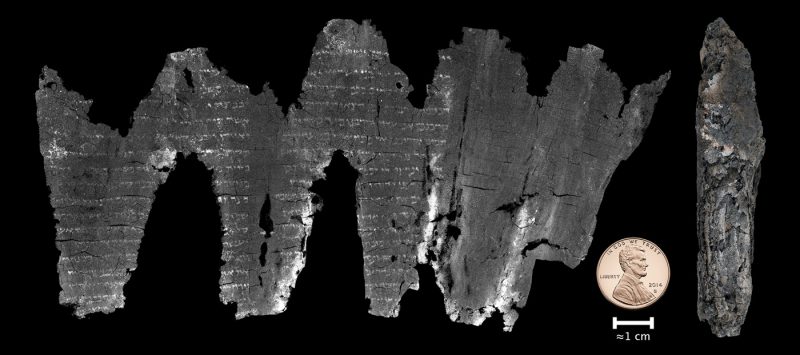When the En-Gedi scrolls were excavated from an ancient synagogue’s Holy Ark in the 1970s, it was a bittersweet discovery for archaeologists. Though the texts provided further evidence for an ancient Jewish community in this oasis near the Dead Sea, the scrolls had been reduced to charred lumps by fire. Even the act of moving them to a research facility caused more damage. But decades later, archaeologists have read parts of one scroll for the first time. A team of scientists in Israel and the US used a sophisticated medical scanning technique, coupled with algorithmic analysis, to “unwrap” a parchment that’s more than 1,700 years old.

The recovery process was described in a research article published in Science Advances by William Brent Seales, Clifford Seth Parker, Michael Segal, Emanuel Tov, Pnina Shor and Yosef Porath titled “From damage to discovery via virtual unwrapping: Reading the scroll from En-Gedi”.
The research article is available under a Creative Commons Attribution-NonCommercial license. The abstract summarises the reports as follows:
Computer imaging techniques are commonly used to preserve and share readable manuscripts, but capturing writing locked away in ancient, deteriorated documents poses an entirely different challenge. This software pipeline—referred to as “virtual unwrapping”—allows textual artifacts to be read completely and noninvasively. The systematic digital analysis of the extremely fragile En-Gedi scroll (the oldest Pentateuchal scroll in Hebrew outside of the Dead Sea Scrolls) reveals the writing hidden on its untouchable, disintegrating sheets. Our approach for recovering substantial ink-based text from a damaged object results in readable columns at such high quality that serious critical textual analysis can occur. Hence, this work creates a new pathway for subsequent textual discoveries buried within the confines of damaged materials.
I am utterly fascinated by stories like this, especially when it comes to recoveries of ancient texts and artifacts in Israel. These discoveries paint a rich picture of Jewish life in Israel going back millennia.

I also love how these modern technologies can be used to reveal these ancient artifacts to the world once again. A great example of this is how the Dead Sea Scrolls have been digitised and made publicly available online through the Leon Levy Dead Sea Scrolls Digital Library.
This is one of the reasons I am a big fan of work being done by the Google Cultural Institute (which powers the Dead Sea Scrolls Digital Library). Despite the copyright concerns some copyright owners raise, Google is doing amazing work preserving our collective culture.
These sorts of stories also remind me of the debate about ephemeral digital content that Snapchat popularised. On the one hand, we produce so much content these days and much of that is only really relevant for short time periods. On the other hand, if we don’t capture even the silly things we share in some form, we could be sacrificing an historical archive, the value of which could only be appreciated in centuries to come.
Digital technologies give us the means to store perfect versions of just about everything. The question is more whether we can solve the challenges of format compatibility so that future technologies will be able to access our content?
Everything we share is a thread in the tapestry of our modern culture and small memes can have the tendency to grow into profound cultural transformations. We almost lost the En-Gedi scrolls entirely to a fire. Thankfully we didn’t and the work of these scientists has completed more of the historical tapestry of my ancestors.

 RSS – Posts
RSS – Posts
What do you think?